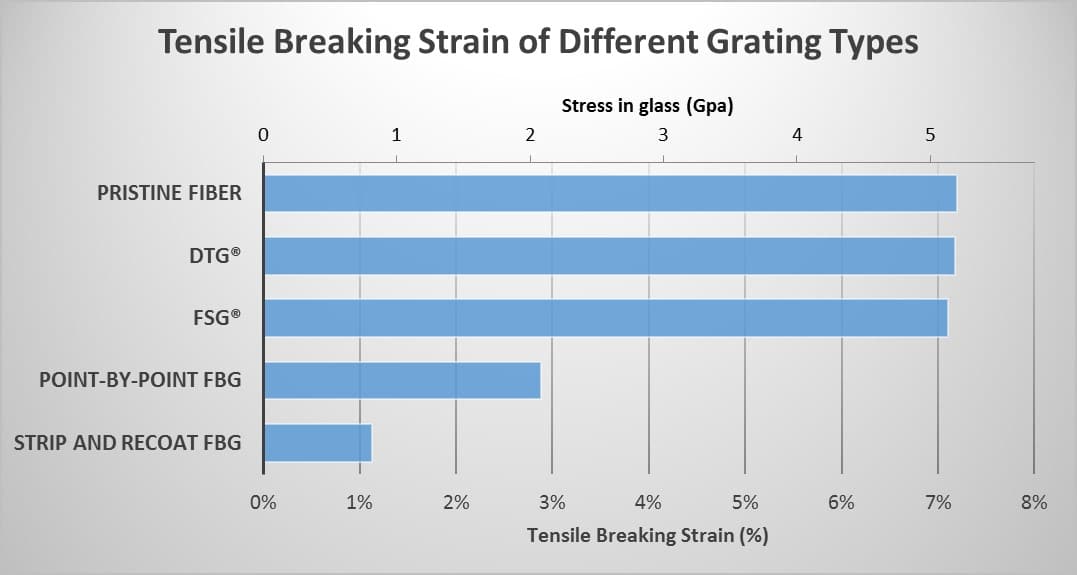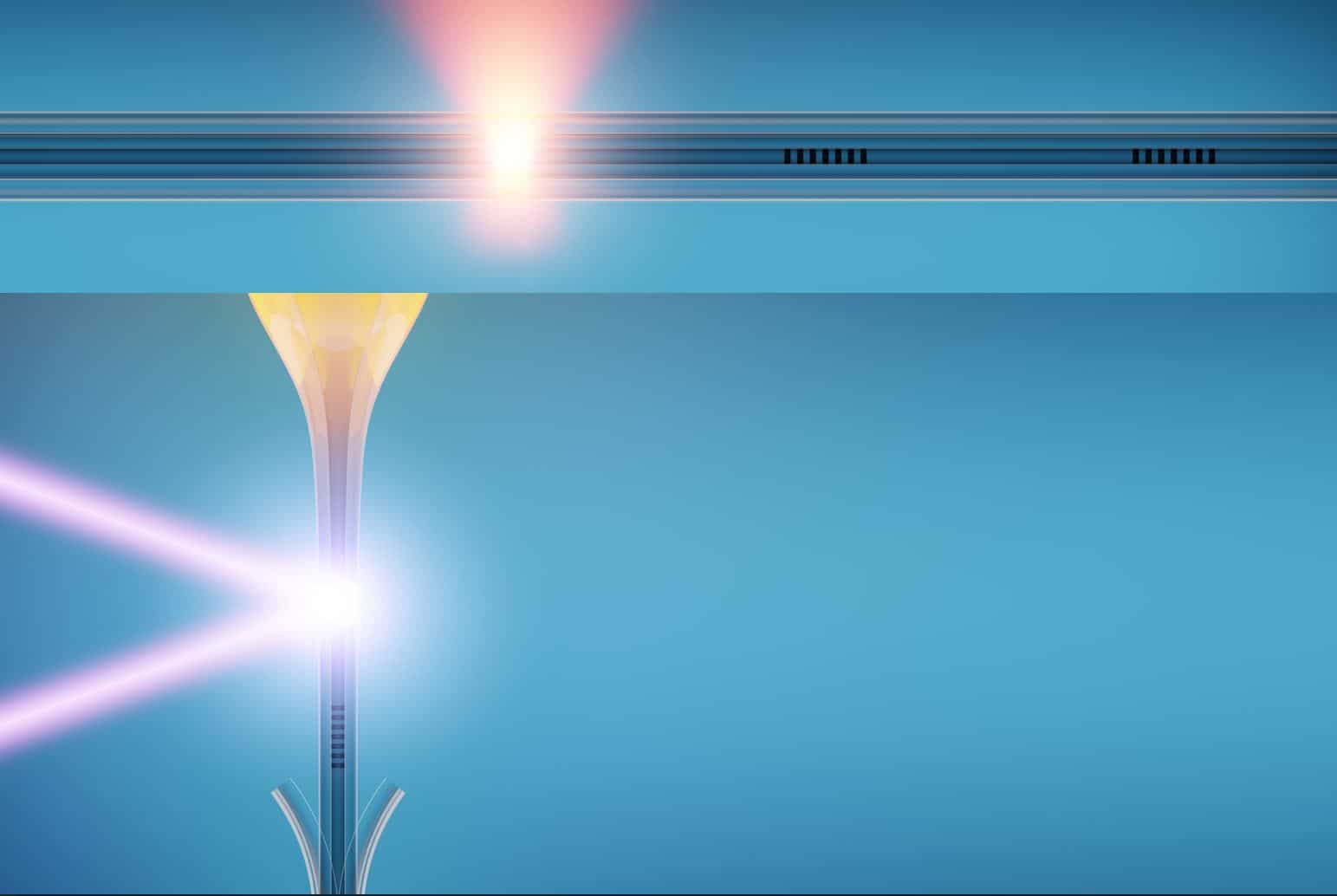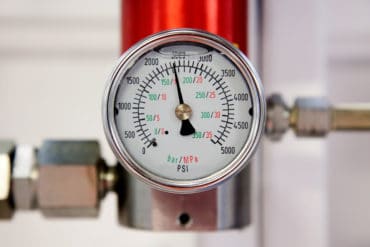Draw Tower Gratings (DTG®)
Draw Tower Gratings (DTG®s) are produced using a process that combines the drawing of the optical fiber with the writing of the grating.
The figure below shows the set-up of this production process. The input of the process is a glass pre-form. After heating the pre-form, the pulling and formation of the fiber will be initiated.
Further in the production process, the fiber crosses the optical axis of a laser and the interferometer that create a periodical UV-light interference pattern in order to write the grating. Using a pulse selector and taking into account the draw speed, FBGs can be accurately positioned in the fiber. When the grating has been written the fiber is coated by entering a coating reservoir, followed by a-curing step of the coating.
Finally the location of the FBG is marked automatically and the fiber is reeled onto a drum. This process of simultaneously drawing the fiber, writing the grating and coating the fiber directly after the grating inscription, results in high strength grating chains. As such the commonly used stripping and recoating process of standard FBGs is not necessary and the pristine fiber strength is maintained during the DTG® manufacturing process.

FemtoSecond Gratings (FSG®)
FBGS’s FemtoSecond Grating (FSG®) technology complements the existing DTG® technology by adding new manufacturing capabilities due to special demands for Fiber Bragg Gratings (FBGs).
The fabrication processes of both techniques maintain the pristine high mechanical- strength of the optical fiber. In addition, FSG®s can provide sensor configurations and features needed for special applications.
FSG® exploits the through-coating FBG inscription process, which utilizes ultrafast laser pulses launched via special optics to the fiber core without damaging the fiber coating. See below the schematic for FSG® inscription.

wind turbine blades
The focused high-power laser pulses change the index of refraction of the glass material in the core of the optical fiber due to nonlinear absorption processes. These effects are nearly independent of the doping level of the optical fiber or the type of glass, which uniquely sets this process to offer an advantage in its ability to modify any type of optical fiber.
The laser pulses are guided via special optics to form a unique interference pattern, which is geometrically co-aligned with the longitudinal axis of a stationary standard optical fiber. The impinging pattern creates the desired modulated index of refraction onto a selected local length along the core of the optical fiber.
This inscription defines the required reflected Bragg wavelength. In addition, an array of desired FBGs can be inscribed by translating the optical fiber along its longitudinal axis.
Advantages of FSG®
FSG® inscription offers additional advantages to the arsenal of DTG® sensors.
- For one, a standard commercially-available telecom optical fiber, such as an SMF-28 (or similar type) or a pure silica core fiber, with different coatings (polyimide, acrylate, etc.) can be used to inscribe the gratings.
- System designers can take advantage of new features, such as; enhanced reflectivity, which can exceed 90%, have a narrow spectral bandwidth (FWHM) down to 200pm and more flexibility in configuring FSG® chains, where spectral spacing between consecutive FBGs is less restricted.
- Additionally, the process offers a capability to fabricate FSG®s with broad FWHM of higher than 5nm with an option to offer low or high reflection values.
- Furthermore, FSG®s offer a higher thermal stability across a wide band of temperatures and can be designed to operate at the temperature limit of the optical fibers.
Advantages of DTG® & FSG®
Within the field of Fiber Bragg Grating (FBG) sensing, FBGS Draw Tower Gratings (DTG®) and FemtoSecond Gratings (FSG®) have some unique properties which makes them the preferred product for many FBG based sensing applications. The most important advantages are summarized below:
1 Extremely high mechanical strength
DTG®s and FSG®s show extreme high mechanical strength. In comparison to the conventional Strip-and-Recoat inscription process, FBGS’s Draw Tower Gratings (DTG®s) and FemtoSecond Gratings (FSG®s) maintain a pristine high mechanical-strength of the optical fiber. Their tensile strength typically exceeds 5GPa, which corresponds to a breakage strain of >7%. In contrast, the alternative femtosecond through-coating process designated as Point-by-Point (PbP) and the classical Strip-and-Recoat manufacturing process suffer from producing sensors with weaker tensile strength of less than 2.9% for the same type optical fiber. The graph below displays the averaged measured breaking force of optical fibers (single FBG in each fiber) with different FBG inscription technologies. It is evident that FBGS´s DTG® and FSG® products offer superior mechanical strength with no significant reduction in the breaking force compared to a pristine optical fiber.

2 Spliceless arrays
The DTG® and FSG® technologies offer unique capabilities to produce spliceless grating chains (arrays) with a high number of sensor elements. The figure below shows the spectrum of an array of 80 DTG®s with different wavelengths.

Comparison of DTG® & FSG® Technology
| Customized FSG® | FSG®-A01 | DTG®-AXXX | |
| High strength | yes | ||
| Uniform coating coverage | yes | ||
| Ge doping level | any (incl. pure silica) | low | high |
| Fiber diameter | 80 μm 125 μm |
125 μm | 80 μm 125 μm |
| Number of gratings in an array | high | medium | unlimited |
| Coating type | any (transparent) | polyimide | Ormocer® Ormocer®-T acrylate |
| Standard wavelength range | any (on request) | 1510–1590 nm | 1460–1620 nm |
| Reflectivity | any (on request) | medium to high | low to medium |
| Bend insensitivity | any (on request) | medium | high |
| Fiber attenuation | any (on request) | low | medium |
| Temperature stability | high | medium | |
| Most cost effective for | low density grating | high density grating | |








WHY USING DTG® OR FSG®?
DTG®s and FSG®s offer unique characteristics compared to classically produced FBGs, such as extremely high breaking-strength, spliceless array configuration and uniform coating coverage.
FBG parameters and coating material can be selected based on customer needs.